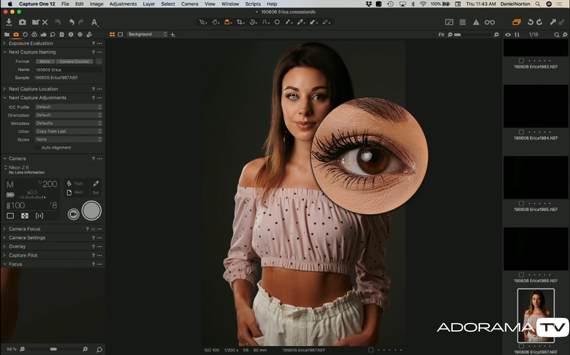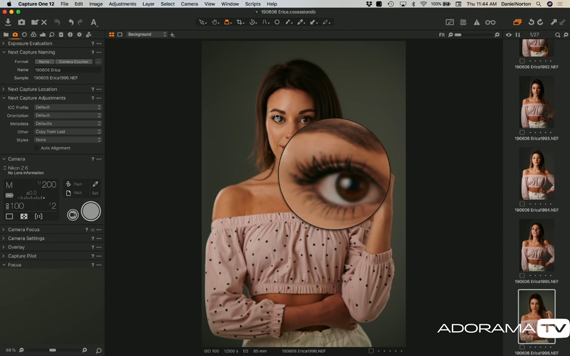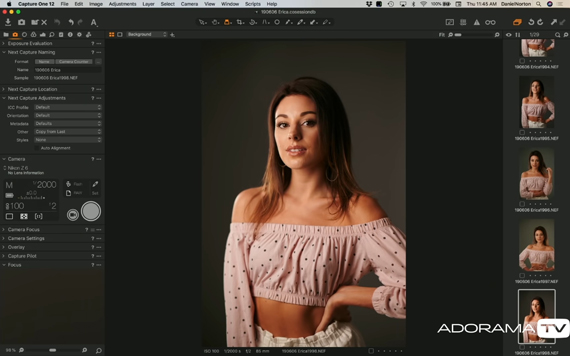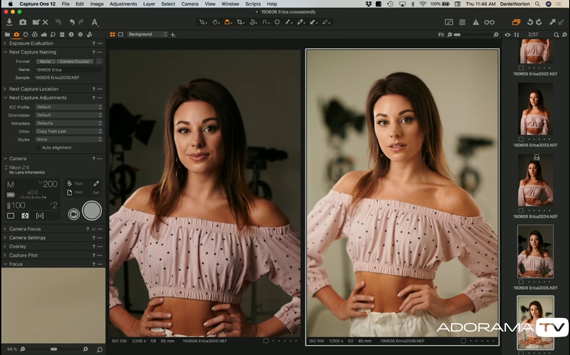Maintaining a proper depth of field is crucial in portrait photography. Depending on what background you are working with, or how much of the subject you want in focus, you will need to vary your aperture accordingly. In this video, photographer Daniel Norton from Adorama demonstrates circumstances where shooting wide open is important. He also discusses situations where narrow apertures work best. Lastly, he explores a bit of High-Speed Sync (HSS) that’ll let you use any aperture irrespective of the lighting conditions:
Working with Narrow Aperture
When working in a studio, you tend to use plain backgrounds. Therefore it doesn’t matter much whether the background is in focus or not. What matters most is that the subject should be in sharp focus. If you choose to work with a wide aperture like f/1.2, chances are that even the slightest movement will throw the focus off. To overcome such issues, it is a good idea to work with a relatively smaller aperture like f/8.

“Another bonus to shooting at f/8 is that I can eliminate all the window light without too much trouble.”
When shooting at f/8, even if the model moves around a bit, chances of them being out of focus is minimal. Thus, you don’t need to worry too much about losing focus.
Working with Wide Aperture
When you work with wide aperture like f/2, the depth of field is greatly reduced. You thus have a greater chance of missing focus. You also need to make sure that the camera and the subject don’t move once the focus is locked. Any slight movement will increase your chances of missing focus. Also keep in mind that even when the subject is in focus, the focus will drop off rapidly when working with wide aperture.

It is quite easy to miss focus when working at wide aperture due to the shallow depth of field.
Another thing you will notice is that the ambient light will creep into the shot. For instance, if you look at Norton’s image that he took at f/2, the background is not completely dark.
In order to get rid of the ambient light, you can increase your shutter speed. In most cases, you will need to exceed your flash sync speed. This means that you will need to work with high-speed sync (HSS).
“High-speed sync allows the flash to shoot above the normal sync speed.”
In the image below that Norton shot at f/2, and 1/2000 of a second, you can notice the dark background with only the flash affecting the image. Such a fast shutter speed also reduces the risk of any motion blur. However, the depth of field is still shallow and so the focus falls off pretty quickly.

Working with wide aperture however comes in handy, especially when there’s something in the background that you don’t want in focus. If you’re shooting out on the streets, this can be an easy way to get rid of unwanted things in the background.

Don’t only shoot wide every time just because you bought a new fast lens. Decide on the depth of field depending on how much of the subject and the environment you want in focus.
- - - - - - - - - - - - - - - - - - - - - - - - - - - - - - - - - - - - - - - - - - - - - - - - - - - - - - - - - - - - - - - - - - - - - - - - - -
Did you appreciate this newsletter? Please help us keep it going by Joining Our Patreon Supporters
What are your thoughts on this article? Join the discussion on our Facebook Page
PictureCorrect subscribers can also learn more today with our #1 bestseller: The Photography Tutorial eBook
- - - - - - - - - - - - - - - - - - - - - - - - - - - - - - - - - - - - - - - - - - - - - - - - - - - - - - - - - - - - - - - - - - - - - - - - - -
The post Deciding on Depth of Field for Portraits (Video Tutorial) appeared first on PictureCorrect.
from PictureCorrect https://ift.tt/fGTv8xo
via IFTTT






0 kommenttia:
Lähetä kommentti